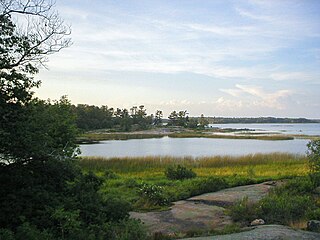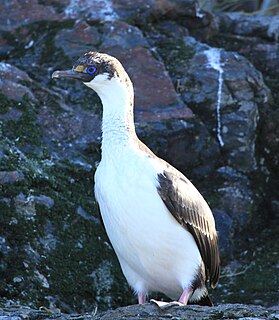
The Antarctic is a polar region around the Earth's South Pole, opposite the Arctic region around the North Pole. The Antarctic comprises the continent of Antarctica, the Kerguelen Plateau and other island territories located on the Antarctic Plate or south of the Antarctic Convergence. The Antarctic region includes the ice shelves, waters, and all the island territories in the Southern Ocean situated south of the Antarctic Convergence, a zone approximately 32 to 48 km wide varying in latitude seasonally. The region covers some 20 percent of the Southern Hemisphere, of which 5.5 percent is the surface area of the Antarctic continent itself. All of the land and ice shelves south of 60°S latitude are administered under the Antarctic Treaty System. Biogeographically, the Antarctic ecozone is one of eight ecozones of the Earth's land surface.

The wandering albatross, snowy albatross, white-winged albatross or goonie is a large seabird from the family Diomedeidae, which has a circumpolar range in the Southern Ocean. It was the last species of albatross to be described, and was long considered the same species as the Tristan albatross and the Antipodean albatross. A few authors still consider them all subspecies of the same species. The SACC has a proposal on the table to split this species, and BirdLife International has already split it. Together with the Amsterdam albatross, it forms the wandering albatross species complex. The wandering albatross is one of the two largest members of the genus Diomedea, being similar in size to the southern royal albatross. It is one of the largest birds in the world and has the greatest known wingspan of any living bird, and one of the best known and studied species of bird in the world. This is also one of the most far ranging birds. Some individual wandering albatrosses are known to circumnavigate the Southern Ocean three times, covering more than 120,000 km (75,000 mi), in one year.

The black-browed albatross, also known as the black-browed mollymawk, is a large seabird of the albatross family Diomedeidae; it is the most widespread and common member of its family.

The king penguin is the second largest species of penguin, smaller, but somewhat similar in appearance to the emperor penguin. There are two subspecies: A. p. patagonicus and A. p. halli; patagonicus is found in the South Atlantic and halli found at the Kerguelen Islands and Crozet Island, Prince Edward Islands, Heard Island and McDonald Islands, and Macquarie Island.

The Antarctic fur seal, sometimes called the Kerguelen fur seal, is one of eight seals in the genus Arctocephalus, and one of nine fur seals in the subfamily Arctocephalinae. As its name suggests, the Antarctic fur seal is distributed in Antarctic waters. Around 95% of the world population breeds at the Island of South Georgia.

Georgian Bay Islands National Park consists of 63 small islands or parts of islands in Georgian Bay, near Port Severn, Ontario. The total park area is approximately 13.5 km2 (5.2 sq mi). Prior to the creation of Fathom Five National Marine Park, Flowerpot Island was also a part of the park.

Bird Island is 4.8 kilometres (3 mi) long and 800 metres (875 yd) wide, separated from the western end of South Georgia by Bird Sound. It is part of the British overseas territory of South Georgia and the South Sandwich Islands, also claimed by Argentina as part of Tierra del Fuego province.

The Scotia Sea is a sea located at the northern edge of the Southern Ocean at its boundary with the South Atlantic Ocean. It is bounded on the west by the Drake Passage and on the north, east, and south by the Scotia Arc, an undersea ridge and island arc system supporting various islands. The sea sits atop the Scotia Plate. It is named after the expedition ship Scotia.

The grey-headed albatross also known as the grey-headed mollymawk, is a large seabird from the albatross family. It has a circumpolar distribution, nesting on isolated islands in the Southern Ocean and feeding at high latitudes, further south than any of the other mollymawks. Its name derives from its ashy-grey head, throat and upper neck.

The Antarctic tern is a typical tern. It ranges throughout the southern oceans. It is very similar in appearance to the closely related Arctic tern, but is stockier, and the wing tips are grey instead of blackish in flight. It is in breeding plumage in the southern summer, when the Arctic tern has moulted to its non-breeding plumage.

The Antarctic prion also known as the dove prion, or totorore in Maori, is the largest of the prions, a genus of small petrels of the Southern Ocean.

The South Georgia diving petrel or Georgian diving-petrel is one of five very similar small auk-like diving petrels of the southern oceans. It is native to the South Atlantic and islands of the southern Indian Ocean and south-eastern Australia.

The South Georgia shag, also known as the South Georgia cormorant, is a marine cormorant native to South Georgia and a few other subantarctic islands in the South Atlantic Ocean.
Clathria stromnessa is a species of demosponge first found on the coast of South Georgia island, in the south west Southern Ocean.
Myxilla ponceti is a species of demosponge first found on the coast of South Georgia island, in the south west Southern Ocean.
Mycale brownorum is a species of demosponge first found on the coast of South Georgia island, in the south west Southern Ocean.
Haliclona crowtheri is a species of demosponge first found on the coast of South Georgia island, in the south west Southern Ocean.
Microxina myxa is a species of demosponges first found on the coast of South Georgia island, in the south west Southern Ocean.
Calyx shackletoni is a species of demosponge first found on the coast of South Georgia island, in the south west Southern Ocean.














